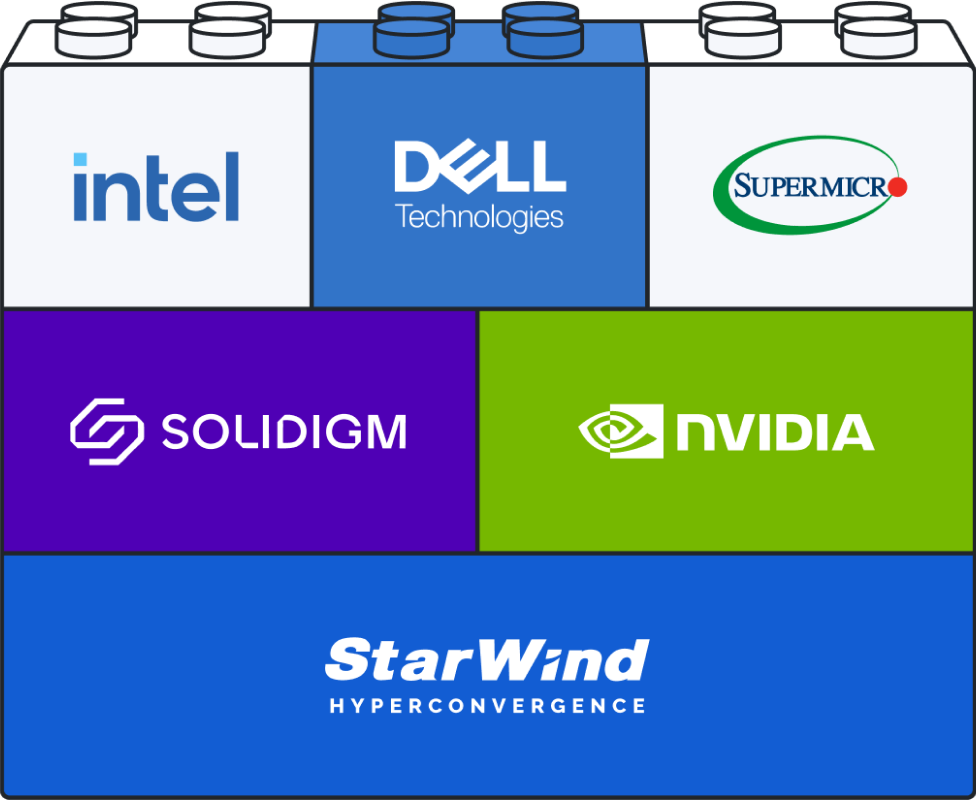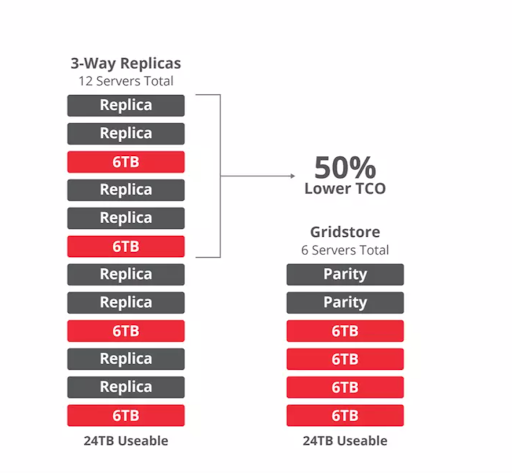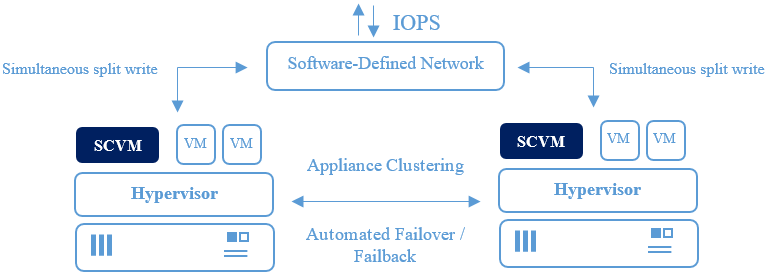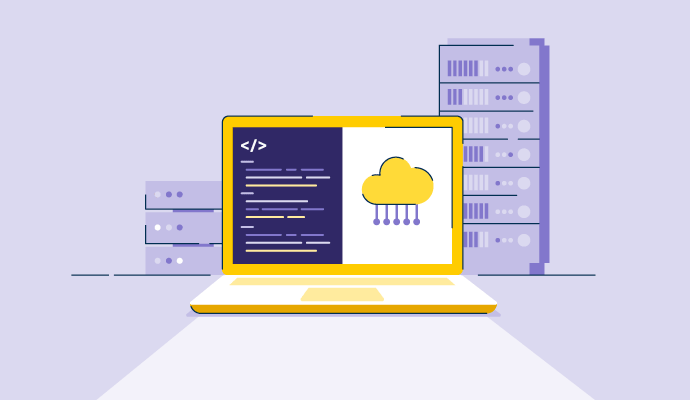Hyperconverged appliances are integrated solutions that optimize data center operations and resource usage.
Unlike traditional, siloed infrastructures, where each resource functions independently, hyperconverged appliances consolidate these elements in a device, making it easier to deploy, manage, and scale IT.
This architecture simplifies infrastructure management and enables data centers to respond rapidly to changing business demands. Many IT teams rely on hyperconverged infrastructure (HCI) solutions to modernize their data center to scale for business continuity and availability.
Let’s explore HCI appliances in-depth and learn more about their features that help scale IT efficiently.
What is a hyperconverged appliance?
Hyperconverged appliances, also known as hyperconverged infrastructure (HCI) appliances, are a building block for modern data centers that replace expensive legacy infrastructure. They tightly combine servers, compute, and storage all in one box, eliminating maintenance costs and complicated management in traditional infrastructure.
In legacy data centers, storage, compute, and servers existed as siloed components, contributing to lower power efficiency. A hyperconverged appliance makes traditional data centers more efficient by optimizing the use of power across all infrastructure components.
Here’s an example of a hyperconverged appliance:
 Source: StarWind
Source: StarWind
Hyperconverged appliances are characterized by software-centric architecture integrating storage, compute, networking, and virtualization resources. Companies sell them as integrated bundles, such as Dell VxRail or StarWind HCI Appliance. It might have different hardware or hypervisor vendors. However, they work seamlessly with each other, where the vendor offers a single point of contact for any tech support requirements.
The hypercovergence model evolved from converged infrastructure, aggregating data center components into one appliance. It helped minimize compatibility issues while reducing expenses on cabling and space.
Hyperconverged appliances vs. traditional infrastructure
Hyperconverged appliances form the hardware foundation of hyperconverged infrastructure (HCI). They offer a streamlined alternative by integrating storage, compute, and networking into one device. It makes it easier to deploy applications with minimal configuration.
Traditional data center infrastructure typically consists of separate compute, storage, and networking components, each managed independently. Handling these resources independently can be tricky, causing administrative challenges for IT teams.
Scaling up these resources can also be difficult and costly, often necessitating intricate planning and the addition of specific hardware. The physical footprint also expands with traditional setups due to the extra hardware, such as dedicated storage area networks (SANs), which raises space and cost requirements.
Want to learn more about Hyperconverged Infrastructure (HCI) Solutions ? Explore Hyperconverged Infrastructure (HCI) Solutions products.
Hyperconverged appliance features
Based on the use case, the feature set of the HCI appliance varies. On the one hand, the HCI appliance will help with all-flash storage and non-volatile memory express storage for high-performance workloads. On the other hand, if a hyperconverged appliance is used for a virtual desktop, the storage alternatives will likely be less expensive.
The features of HCI appliances are primarily based on security and interoperability.
- Flash storage arrays. They’re also known as all-flash arrays (AFA) or solid-state arrays (SSA) that use flash memory drives instead of spinning disk drives. They deliver rapid access speed, helping real-time data processing in high-performance use cases.
- Hypervisor of choice. A hosted hypervisor running on Linux or Windows is more compatible than bare metal virtualization hypervisors. The support for these operating systems helps design servers. However, a bare metal virtualization hypervisor is a reliable choice for high-performance use cases requiring advanced resource control.
- Out-of-band management. Any devices with network access and a power source can be managed with out-of-band management. You can reach devices regardless of where they’re located (on or off-site), whether inside or outside the corporate firewall.
- Memory to run the desired workload. If the workload uses a lot of in-memory tables, the HCI nodes will need a lot of random access memory (RAM). In-memory tables store data and delta file pairs.
- Scalability. HCI is best suited for workloads that scale linearly, where the computing resources grow at similar rates.
- Flexibility and vendor support. HCI appliances are typically sold as an integrated bundle with vendor support. However, their hardware components can be flexibly configured to match HCI requirements such as memory, processor, storage, and network connectivity.
- High availability. Systems can operate continually even when components fail. Nutanix Cloud Infrastructure (NCI) and VxRail are some HCI appliances that offer high availability.
- Native integration. Some HCI architectures offer native Windows integration by installing a software driver at the Windows kernel level. This offers the tightest possible integration while eliminating guest virtual machine complexity.
- End-to-end input-output (I/O) control per virtual machine. You get complete visibility and control with the HCI appliance’s Quality of Service (QoS). QoS is a set of technologies and techniques that optimize network performance by controlling traffic and prioritizing applications. It improves performance for critical virtual machines.
- Efficient elastic scaling. Some HCI appliances offer a pay-as-you-grow model that eliminates the need for 3-way replicas when you grow, reducing waste and improving central processing unit (CPU) usage. This is illustrated in the example below.
Did you know? A server replica duplicates processes and assigns the replicas to different systems. When you grow, these replicas allow for load balancing and better performance since they are identical and can process the same requests.
 Source: Slideshare
Source: Slideshare
HCI nodes are hardware or virtual resources grouped into a cluster, providing the appliance's block storage and compute capabilities. HCI requirements take into account that all HCI nodes have similar components. Earlier, it was difficult to upgrade HCI nodes. However, modern vendors provide nodes where you can upgrade their components.
Hypeconverged appliances use cases
Hyperconverged appliances typically support business continuity for mission-critical applications. This section provides a detailed overview of these use cases.
- Ensuring business continuity. Enterprises have critical business applications that can’t risk service interruptions or downtime. If they experience any interruption, it leads to financial losses. To ensure consistent service, you need fault-tolerant hardware and software with servers, networking, and hypervisors. Conventionally, these components were installed separately, but this increased cost and complexity in management and created multiple points of potential failure. HCI appliances solve this by integrating all components into one platform that can withstand faults.
- Enabling remote office and branch office (ROBO) and edge. As businesses expand globally, different locations need local processing power and a centralized IT approach. An HCI appliance delivers a scalable platform that combines servers, storage, networking, and hypervisor requirements with centralized management powering diverse ROBO workloads and unmanned edge environments.
- Virtual desktop infrastructure (VDI). Each hyperconverged appliance can support up to 600 desktops in a typical deployment. As VDI scales in uniform chunks, an HCI appliance is a fast and easy way to scale these deployments as the number of desktops increases.
- Cloud in a box. HCI appliances can be installed and up and running the same day, helping deploy applications or migrate from existing environments.
Benefits of hyperconverged appliances
Below are some notable benefits of HCI appliances.
- Hybrid-cloud ready. HCI appliances offer a complete, turnkey, and automated solution in hybrid cloud environments. They make it easier to deploy applications quickly.
- Managing operations consistently. It delivers a consistent operational experience from core to edge to cloud through full-stack integration and automated lifecycle management.
- Ensuring powerful performance. It allows businesses to manage workloads while ensuring the reliable performance of applications like SAP or Oracle that are critical to business applications.
- Modernizing data center. It offers automation, operational processes orchestration, and lifecycle management to drive rapid IT transformation and management.
“We use hyperconverged appliances for virtualization and disaster recovery. They're perfect for disaster recovery because of built-in backup and replication tools. We've also used them in dev and testing environments where spinning up resources quickly is key.”
Matthew Lam
Full-Stack Developer at Penfriend
Traditionally clustered HCI appliance challenges
Although HCI appliances make it easier to scale IT and related operations, they present a few challenges for IT teams when they're traditionally clustered.
Need for on-site staff for smooth operations
You need dedicated, skilled IT staff on-site to ensure that servers, network switches, and storage are constantly running at peak performance. When high availability is a non-negotiable, dedicating such a team adds substantial costs for the IT department, making it tricky for businesses to afford it in some situations.
Managing complex data and orchestration
You cluster HCI appliances to ensure they deliver high availability. However, the traditional route is time consuming, often complex, and error-prone. Teams must put the pieces together to handle enterprise workloads while troubleshooting effectively.
Data management increases the cost above it as you add third-party services for storage optimization, making it costly for businesses. The total cost of ownership (TCO) increases when you factor in on-site IT staff, hardware issues, software updates, third-party add-ons, and similar expenses.
Exploring the need for dual clustered HCI appliances
Some HCI appliances have a dual-node system that automatically switches over whenever the local area network (LAN) or wide area network (WAN) has any issue. The dual nodes keep data accessible without compromising downtime, making it a suitable HCI solution for enterprises that can’t risk downtime.

Source: StoneFly
Here’s the architecture of a dual-clustered HCI appliance:
These dual clustered HCI appliances save space in data centers while replacing separate servers, storage, and switches with scalable virtual machines.
Using software-defined networking, such HCI appliances write on both nodes simultaneously, ensuring both HCI appliances have full copies of data. The system automatically switches to another node whenever one node goes down for maintenance or due to adverse circumstances. This keeps the business running and helps avoid any service interruptions.
Add agility to your data center
Hyperconverged appliances offer a unified approach to modern data center management. They improve operational agility and reduce costs while keeping the services uninterrupted in adverse business situations.
As you consider your data center’s future, take the time to assess your specific needs, set clear objectives, and evaluate the potential return on investment. Adopting hyperconverged infrastructure solutions helps your organization become more efficient and flexible in dynamic IT environments.
Learn more about software-defined storage and explore how it solves IT operations bottlenecks.

Sagar Joshi
Sagar Joshi is a former content marketing specialist at G2 in India. He is an engineer with a keen interest in data analytics and cybersecurity. He writes about topics related to them. You can find him reading books, learning a new language, or playing pool in his free time.
